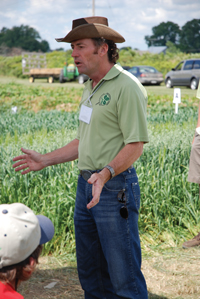
Features
Agronomy
Cereals
For weed control in wheat, timing continues to be everything
When a person’s timing is off on the dance floor, they may fail to impress their partner. When a grower’s timing is off with weed management, the consequences can be far more serious.
April 2, 2010 By Treena Hein
When a person’s timing is off on the dance floor, they may fail to impress their partner. When a grower’s timing is off with weed management, the consequences can be far more serious.

|
| The key message in weed control is that it is more important to control dandelions in March or April than it is to control ragweed in May, says OMAFRA’s Peter Johnson.
Photo by Ralph Pearce.
Advertisement
|
For example, some growers ignore the first seasonal flush of weeds, in the hope of catching the first and early second flush with the same herbicide application. Not only can this result in lower yields, but allowing the first flush to harden makes it much more difficult to control later on.
Peter Johnson, cereal specialist with the Ontario Ministry of Agriculture, Food and Rural Affairs (OMAFRA), observes another common weed management timing problem in winter wheat, one that occurs before the first flush of weeds even appears. “There’s the concept out there that ‘I’m not going to spray until the weeds are there,’ and that’s a mistake,” he says. “If it’s the 25th of April, yes, there’s a very good chance you may see no ragweed, but it’s there under the surface of the soil, at what is called the white stage. If you spray at that point, you’ll kill the weeds before they emerge, and you don’t need a lot of soil activity in your herbicide to do the job.”
Growers can easily investigate their pre-first flush weed situation at around April 20th to 25th by using a hand trowel to remove layers of soil. “You will see the white stage plainly,” Johnson says. “I’ve noticed that some growers who’ve sprayed for chickweed or shepherd’s purse at roughly this point in time don’t have ragweed issues, even though they expected to, because they’ve unknowingly killed it before it emerged.”
Ragweed is easier for a winter wheat crop to compete with than dandelions, notes Johnson. Winter wheat shows growth in early April or late March, which gives it a whole month of head-start growth on ragweed. However, dandelions (that begin to grow during the previous fall) get a head-start of three to four days’ growth. “In terms of wheat and other cereals, I’d far rather see a weed like ragweed in May than dandelions in March or April,” Johnson notes. “Dandelions in the early spring will compete with a developing crop in terms of yield more than ragweed will with a maturing crop.”
The situation is different with spring wheat, however. “It’s more affected by weeds, so you can’t ignore them to the same extent as you can in winter wheat,” says Johnson. “In addition, planting date has a large effect on how to control weeds in spring wheat.”
Other timing issues
Some growers believe a late flush of weeds must be dealt with to prevent impact on harvestability. That can certainly be true, especially in IP soybeans, says Tara McCaughey, technical crop manager at Syngenta, but she would rather see growers act early in the season to prevent the issue in the first place. “If you’ve done everything correctly up front and kept your fields clean,” she observes, “you may not have to worry about late flushes – they will be minimal and won’t impact harvestability. And of course, this way you will also maximize yield.”
The research of Dr. Clarence Swanton, professor in the Department of Plant Agriculture at University of Guelph, has established that maximizing yield can be accomplished by ensuring there is a critical weed-free period for young crop plants. In corn, according to Swanton, this stretches from the three- to eight-leaf tip stage of corn growth. In soybeans, it occurs from the first to third trifoliate leaf. His team’s studies have also attempted to define the critical period for weed control in barley. “Results from this study would suggest that weeds should be controlled before the third leaf stage,” he says.
In short, Swanton’s research has pinned down exactly how the presence of weeds impacts the rate of development of roots and leaves, biomass accumulation and overall fitness in young crop plants. “We’ve found that plants communicate with each other using the light that’s reflected from green leaf and stem surfaces,” says Swanton. “Light quality signals reflected from weed surfaces are detected by crop plants, and this triggers them to grow differently.”
Swanton’s studies of corn show that at the fourth leaf tip stage, plants grown without weeds show a total average root volume of 1.58 cm3 compared to 1.25 cm3 in plants grown with weeds. “We also see that many more crown roots develop: 11.6 in weed-free conditions versus seven in weedy, and they’re also longer,” says Swanton. “In addition, the seminal roots were larger in diameter, and the rate of root development changed, which can result in greater plant-to-plant variability.”